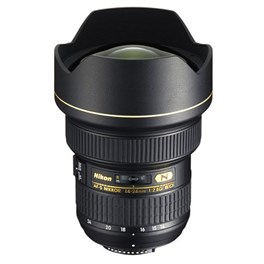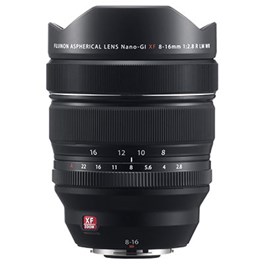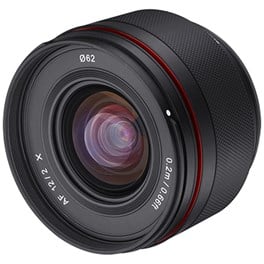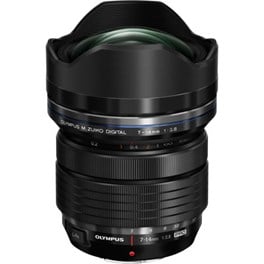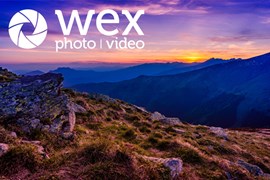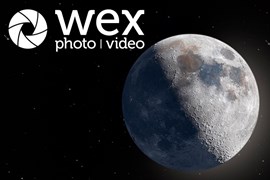
Picking the best lens for astrophotography can be a trickier task than in other disciplines. Note that for now we’re talking about astrophotography in terms of night-sky imaging without a telescope – shooting with a camera attached to a telescope is a different discipline that opens up your lens options in different ways.
Here, we’re talking starscapes and nightscapes, and ideally for nightscape images you want a wide-angle lens, ideally as wide as possible, and there are a few reasons for this. Wide-angle lenses allow you to get more of the sky in frame, yes, but there’s another factor in it for astrophotographers. When shooting stars, something that’s necessary to keep in mind is what’s called the “500 Rule”.
This rule states that to get clear, pin-point images of stars without them blurring across the sky as the Earth moves, the maximum exposure time you can use is the number 500 divided by the focal length of your lens. So for, say, a 20mm lens, you would divide 500 by 20 to get an exposure time of 25 seconds. But if you had a 135mm lens, it would work out to an exposure time of about 3.7 seconds. In astro, it’s critical to gather as much light as possible, so a short focal length is a huge advantage.
This means the other critical thing a good astro lens needs is a wide maximum aperture – letting you make the most of those exposure times. But more than that, it actually needs to perform well at that aperture. An f1.8 lens isn’t much good for astro if all it produces at that setting is a blurry mess.
While all lenses are reviewed and rated for their ability to control distortion, aberration and other optical artefacts, there’s one such artefact in particular that concerns astrophotographers – coma, also known as comatic aberration (not to be confused with chromatic aberration).
This is a specific type of distortion that particularly affects astro images as it causes small points of light towards the edges of frame to appear stretched and distorted – making stars appear, in effect, “comet-shaped”. A good astro lens should have an optical construction specifically designed to control coma, which normally involves a number of aspherical elements (as it’s light hitting spherical elements that causes the effect). The result, ideally, is a lens that produces pin-sharp images from edge to edge, corner to corner.
There’s plenty more we could get into – but you’re here for the lenses, right? We’ve divided the guide up by manufacturer to make it easier to navigate, so let’s crack on and count off the best lenses for astrophotography.
Quick Navigation
Best Canon Lens for Astrophotography
Whether you’re using an RF-mount mirrorless camera or an EF-mount DSLR, Canon offers a lot of lens options when it comes to astrophotography. Both systems have plenty of incredibly sharp wide-angles, both zooms and primes, and while the RF system is much younger, it benefits from the ability to take EF lenses via the EF-EOS R adapter, meaning mirrorless shooters get the best of both worlds.
Canon’s “L” lenses are its best in show – these are the lenses that have been optimised for professional use, and will deliver the kind of sharpness at large apertures that is often necessary for capturing a legible night-sky image. While there are plenty of terrific Canon primes of course, we’ve focused on its high-end wide-angle zooms for this section of the guide.
Canon RF 15-35mm f2.8L IS USM Lens
If you are looking for a fast, sharp ultra-wide angle RF lens, then look no further. Canon's RF 15-35mm F2.8L IS USM lens is packed with features and stunning craftsmanship that makes it the perfect lens for landscape and architectural photography, but could easily be used in other avenues of photography. The lens features a nano USM motor system that allows for a quick, silent and smooth autofocus and it also has 5 full stops of image stabilisation which will help you to capture shake-free photos.
£2,399.00 View
Pros:
- Stellar image quality
- Performs particularly well at widest setting
- Lightweight for a lens of its type
Cons:
- Priced for pros
A stunner of a lens for astrophotography, Canon’s RF 15-35mm f2.8L IS USM is the widest member of its “trinity” of f2.8 lenses for pros, consisting also of the 24-70mm f2.8 and the 70-200mm f2.8. Naturally, it delivers absolutely top-notch image quality throughout its range, but one thing that’s particularly handy for astrophotographers is the fact that it performs extremely well at its wide end – which isn’t normally the case. So shoot at 15mm, extend those exposure times and be well.
The RF 15-35mm is durably built and perfectly suited for outdoor work. The only stumbling block over this lens is that it’s priced at the professional level – if it’s out of your budget, try the Canon RF 16mm f2.8 STM, a budget lens with a wide angle of view and fast aperture.
Canon EF 16-35mm f2.8L III USM Lens
The Canon EF 16-35mm f2.8L III USM Lens is a large-diameter, double-surfaced glass moulded, ultra-wide angle lens and an upgrade to the well-received Canon EF 16-35mm f2.8 L MKII USM Lens. Offering a fast f/2.8 aperture along with an advanced autofocus system, and ultra-high performance, this lens delivers premium image quality that is evident throughout the entirety of the focal length range.
£2,389.00 View
Pros:
- Terrific quality across field of view
- Well built
- Constant f2.8 aperture
Cons:
- Pro level price
For DSLR users, this gorgeous wide-angle zoom is absolute gold for nightscape and star photography. It performs brilliantly throughout its zoom range, and the corner sharpness of this Mark III version is much-improved compared to previous iterations. The Canon EF 16-35mm f2.8L USM III has a constant aperture of f2.8, meaning you can push in if you want without having to worry about changing the exposure, and it’s a beautifully built lens that can withstand the rigours of outdoor use.
This lens has been around for a good few years now, so astrophotographers have had plenty of time to test it out. A quick google will be enough to show you the kinds of results that astrophotographers have been getting with this lens – it really is tried and tested. We can recommend this one without hesitation.
Best Nikon Lens for Astrophotography
You’re in good company here. Astro images have been taken on Nikon kit for decades, and nowadays the prospective star photographer has two great Nikon systems to choose from. Maybe you’re eyeing up the newer Z series of mirrorless models – in which case, you’ve got a fantastic range of powerful, lightweight lenses to choose from. Of particular note is Nikon’s ‘S’ Line, which denotes its top-flight lenses for Z-mount, boasting premium performance wrapped in a durable body.
You may also want to use a Nikon DSLR, in which case, the entire Nikon F-mount ecosystem is open to you, including a few famous wide-angle zooms that more than a few competition-winning images have been taken on. And remember, you can also use the FTZ adapter to fit Nikon F lenses to Nikon Z cameras, so mirrorless users especially have a lot of choice in front of them.
Nikon Z 14-24mm f2.8 S Lens
Nikon has produced yet another incredibly high-quality and professional Z-mount lens. This lens offers an ultra-wide angle of view and a versatile zoom range which is designed for landscape, architecture and astrophotography. But, despite its main focus, it has a minimum focusing distance of 0.28m which means this lens can be used for close-up photography too. Furthermore, its maximum f2.8 aperture and 9-rounded-blade aperture diaphragm will help to produce beautifully circular and pleasing bokeh, helping the isolation of subjects in your frame. The lens sees various coatings that maintain pin-sharp images and reduced flare and ghosting. Finally, the lens is surprisingly lightweight and compact for an ultra-wide-angle lens and thanks to this profile, Nikon has included a specialised lens hood that allows the use of 112mm screw-on filters, adding to the versatility of this lens.
£2,019.00 View
Pros:
- Very portable for a lens of this type
- Excellent performance across zoom range
- Weather-sealed build
Cons:
- Pro-level pricing
This is the upgrade or sequel to a famous DSLR lens for F-mount (which, spoiler, is featured below). However, Nikon didn’t just rush out the same old lens with a new mount, but redesigned its 14-24mm f2.8 offering from the ground up. With a construction of 16 high-quality elements in 11 groups, the Nikon Z 14-24mm f2.8 S is an absolute beast of a lens that will delight any Z-series wielding astrophotographer.
Image quality is stunning throughout the range, with great control of chromatic aberrations and coma. It does very well at maximum aperture – but one thing that’s particularly delightful about this lens is how lightweight it is. At 650g, it’s distinctly more heftable than its F-mount predecessor (which is pushing a kilogram), and this reduction in weight definitely suits the lighter, more nimble Z-series cameras.
Nikon 14-24mm f2.8 G AF-S ED Lens
A wide-angle, fast aperture lens with a revolutionary optical design, the Nikon 14-24mm f2.8 G AF-S ED Lens features a Nano Crystal coating to reduce the effects of ghost and flare, and delivers edge-to-corner sharpness that can surpass that of equivalent fixed focal-length lenses. The Silent Wave Motor (SWM) feature provides swift autofocus with superior accuracy and ultra-quiet operation.
£1,619.00 View
Pros:
- Excellent wide-angle sharpness
- Designed to eliminate coma
- Durably built
Cons:
- Weighs a kilo
- No filter attachment thread
No one’s about to argue with a Nikon DSLR being a great choice for astrophotography, and if you want a pin-sharp astro lens to go with it, you’ll have a hard time beating the Nikon 14-24mm f2.8 G AF-S ED. Its optical design includes a number of precisely moulded aspherical glass elements that are specifically designed to eliminate coma and other types of aberration, and its Nano Crystal Coat minimises ghosting and flare.
Weighing almost a full kilogram, this is a brick of a lens, but once you get it up and shooting you’re unlikely to resent the bulk too much. It’s resistant to dust and moisture, and it still produces gorgeous images even at its widest focal setting and largest aperture setting – which is just what astrophotographers want to hear. For F-mount users, this is the absolute best choice.
Best Sony Lens for Astrophotography
Sony shooters are in for a treat, as the E-mount lens range is absolutely spoiled when it comes to fantastic astro lenses. You may well have settled on one of Sony’s full-frame Alpha cameras like the A7 III or the low-light monster A7S III as your astrophotography weapon of choice – if so, you’ve got a lot of fantastic wide-angle lenses to choose from that will make the most of their fantastic imaging capabilities. In particular, the pro-level G Master lenses are absolutely stellar.
But it’s not all about the high-end stuff – those who are using Sony’s more affordable APS-C E-mount cameras have some good options too. Recent additions to the APS-C lens line-up have made Sony’s smaller-sensor cameras more viable than ever for astrophotography, and both the cameras and the lenses will suit anyone looking to try out astrophotography on a budget.
Sony FE 12-24mm f2.8 G Master Lens
Sony's FE 12-24mm F2.8 G Master Lens is a true demonstration of their mastery of professional-level lens optics. This ultra-wide-angle zoom lens will capture stunning sharp and detailed photos and video footage. Sony has equipped the lens with an advanced optical design that includes 3 XA elements, 1 aspherical, 2 super ED and 3 ED glass elements, as well as advanced nanocoatings that ensure edge-to-edge sharpness, full of detail and high-clarity. In addition, this lens has an advanced autofocusing system that delivers impressively fast, accurate and quiet autofocus - More on this below. Sony has designed an incredible lens in the FE 12-24mm, a compact and lightweight design that produces both beautiful photos and video footage.
£2,599.00 inc. Cashback View
Pros:
- Zooms out to 12mm
- Excellent coma control
- Constant f2.8 aperture
Cons:
- Priced for professionals
- No aperture ring
Sony likes its milestones, and on release, the Sony FE 12-24mm f2.8 G Master represented a first of its kind – no other wide zoom offered a constant f2.8 aperture at this focal range. And of course it had to be a G Master lens, Sony’s range of top-notch optics promising excellence in engineering both inside and out. So, as you might be able to imagine, all this adds up to one of the best astrophotography lenses out there, for any system.
The optical construction of this lens is first-rate, including three XA (Extreme Aspherical) lens elements, as well as advanced Nano AR coating II to remove flare and ghosting. Coma flare is exceptionally well controlled, as are other forms of distortion and aberration.
This is a lens for photographers who demand the best. It’s priced as such, but believe us, it earns that price tag.
Sony E 11mm f1.8 Lens
As the widest lens in the Sony APS-C range, the 11 mm Prime is the perfect lens for content creation. The constant f1.8 aperture maintains a beneficial brightness that is invaluable for vloggers moving from one scene to the next. And, by combining a circular 7-blade aperture with a smooth, fast and continuous autofocus performance, this Sony E-Mount lens delivers some truly stunning highlights.
£499.00 View
Pros:
- Widest Sony lens for APS-C
- Great sharpness
- Affordable and lightweight
Cons:
- Arguably limited use cases
The Sony E 11mm f1.8 was an extremely welcome addition to the E-mount line-up in 2022 – making astrophotography a much more viable prospect for users of Sony’s APS-C cameras like the A6600 and the new A6700. Its wide angle of view (equivalent to 16.5mm in full-frame terms) allows you to get plenty of the night sky in and keep those star trails under control. Plus, sharpness is absolutely brilliant from edge to edge, with little distortion or chromatic aberration to speak of. Top stuff.
The 11mm focal length is great for astro, but if you’re someone who likes to mix in other types of photography too, you may find it a little bit limiting for other applications. Still, this is a fairly inexpensive lens, and at 181g it doesn’t add too much weight to your kit bag.
Best Panasonic Lens for Astrophotography
Panasonic mirrorless shooters can be split into two distinct categories – those using Lumix G cameras, who’ll be looking for Micro Four Thirds lenses, and those using the newer full-frame Lumix S series, who will want L-mount lenses. While the two systems are pretty different propositions in terms of handling, performance and price, both can deliver excellent astro images in the right hands.
The smaller sensor of the Micro Four Thirds system means you’re going to have a harder time getting a wider field of view, as the crop factor doubles the effective focal length of the lens (so, a 30mm lens mounted to a Lumix G body will behave like a 60mm lens in use). However, you do get the advantage of plenty of choice – you can also check out the options in our Olympus/OM-System section further down the page, as these fit the same lens mount. Full-frame L-mount users have fewer lenses to choose from overall, but have some absolutely outstanding wide-angle options.
Sigma 14-24mm f2.8 DG DN Art Lens for L-Mount
The Sigma 14-24mm F2.8 DG DN Art has been developed as the ultimate large-diameter, wide-angle zoom lens by optimizing the standard specifications for photographing starry skies for full-frame mirrorless cameras. The uniform rendering performance and outstanding resolution to the edge of the frame make it the "definitive lens for astrophotography." By utilizing the characteristics of the short flange focal length, this new-generation large-diameter zoom lens combines both compact body and unprecedented high-resolution image quality.
£1,319.00 View
Pros:
- Optimised for starry skies
- Generous 114-degree angle of view
- Tough, weatherproof build
Cons:
- No front filter thread
- Relatively heavy
Users of Panasonic Lumix S full-frame cameras have access to the growing L-mount ecosystem of lenses – an alliance developed in partnership with Sigma. As such, L-mount users get to enjoy standout lenses like this, a mirrorless version of a much-venerated SLR lens. Sigma billed the Sigma 14-24mm F2.8 DG DN Art as the "definitive lens for astrophotography" – and, you know what? They have a point.
The edge-to-edge rendering performance of this wide-angle zoom is absolutely sublime. Large-diameter aspherical elements have been included in the optical design specifically to suppress coma flare and achieve exceptionally sharp rendering of stars in the night sky. With a huge angle of view, Sigma’s 14-24mm is perfectly pitched to capture expansive vistas – and its weatherproof build is great for taking outdoors. While there’s no front screw-on filter thread (as is pretty standard for lenses such as this), there is a rear filter holder that lets you slot in square filters if you need to.
Panasonic 15mm f1.7 Leica Summilux DG ASPH Micro Four Thirds Lens - Silver
The Panasonic 15mm f1.7 Leica Summilux DG ASPH lens is a lightweight, fast wide-angle prime with Micro Four Thirds lens mount and robust metal design. The lens allows photographers to capture stunning pictures with beautiful bokeh and offers an angle of view equivalent to 30mm on full frame. The lens incorporates a superior inner focusing system, which enables excellent resolution and contrast from close-up to infinity. The inclusion of a newly developed stepping motor makes the focusing action smooth, silent and quicker for use in both photo and video recording. Furthermore, the lens comes equipped with an aperture ring and AF/MF switch for precise, intuitive operation.
£499.00 View
Pros:
- Reasonably wide field of view
- Nice bright aperture
- Very lightweight
Cons:
- Aperture ring won’t work with Olympus bodies
- 30mm equivalent may be restrictive
This tidy prime from Panasonic is a solid choice for astrophotography. The generous f1.7 aperture gives you plenty of latitude in low light, while the Leica-made optics on the inside deliver impressively sharp images. The angle of view is equivalent to 30mm in full-frame terms – this may not be as wide as you want for astro, but the crop factor is just a fact of life when using Micro Four Thirds.
Some users complain that the aperture ring on the lens only works with Panasonic-made bodies and not Olympus or OM-System ones – while this can be irritating, it’s less of a concern when you’re always using the lens wide open anyway, as you probably will be when shooting the night sky. The all-metal build of the lens is nice and durable, but even so, it only weighs a slender 115g.
Best Fujifilm Lens for Astrophotography
Fujifilm shooters who want to capture the night sky don’t have as many options as those using some other systems, as there are fewer ultra-wide lenses available. However, the ones that are there are absolutely excellent, delivering that pin-point sharpness Fujifilm lenses are known for, with solid weatherproofing and bags of character.
Fujifilm X-mount cameras use APS-C sensors, so there’s a 1.5x crop factor to consider when making your selections. There are excellent options in both zooms and primes for the budding nightscape shooter. It’s also worth looking at third-party options as well as Fujifilm’s own lenses, as there are some real bargains to be found, particularly if you can live without autofocus (which astro shooters generally can). With wide apertures and excellent sharpness, a good Fujifilm X-mount lens helps you make the most of those standout X-Trans sensors and produce spectacular astro images.
Fujifilm XF 8-16mm f2.8 R LM WR Lens
The ultra-wide angle nature of the Fujifilm 8-16mm f2.8 XF R LM WR Fujinon lens makes it a perfect lens for a landscape, architecture or nightscape photographer. The lens offers razor sharp detail across the entire frame and even at the max F2.8 aperture. This constant F2.8 aperture is maintained by the 20 elements in 13 groups, including four aspherical lens elements to control distortion and spherical aberration. In addition, six ED lens elements including three super ED elements will control lateral chromatic aberration. This is truly a stunning lens and its technical superiority goes hand-in-hand with its premium build quality and weather-sealing.
£1,499.00 View
Pros:
- Ultra-wide field of view
- Good control of coma
- Constant f2.8 aperture
Cons:
- It’s a big, hefty lens
This ultra-wide zoom by Fujfilm is well-tailored for photographing the night sky – it controls well not just for chromatic aberrations but in particular for coma, an optical aberration that affects the way points of light are rendered and as such is of great concern to those who want to photography the night sky.
It’s undeniably a hefty proposition, tipping the scales at more than 800g. This is not a lens you’re ever going to forget you’re carrying. But once you’ve lugged it out to your astro location and set it up on the tripod (at which point the weight ceases to be a problem anyway), you’ll be rewarded with some spectacular imagery. The constant aperture of f2.8 lets you experiment along the zoom range without worrying about your exposure, and the lens is built like a tank, so you can take it outdoors for extended shoots without fear.
Samyang AF 12mm f2 Lens for Fujifilm X
As Samyang’s first AF lens specific to Fuji X-mount mirrorless cameras, the Samyang AF 12mm f2 delivers outstanding image quality and a vast 99.1° ultra-wide field of view. This is incredibly beneficial for landscape photographers, whilst the large-diameter aperture, 20cm minimum focusing distance, and newly integrated AF performance suit high-end portrait photography and video productions.
£402.00 View
Pros:
- Beautifully wide field of view
- Excellent edge-to-edge sharpness
- Well-engineered handling
Cons:
- More pronounced vignetting than Fuji’s primes
Replacing the fan-favourite Samyang 12mm f2.0 NCS CS Lens, this lens builds on what was a hidden gem for Fujifilm users. Thsi version offers the same 12mm focal length (18mm equivalent) which again, is wider than most of Fujifilm’s own primes, only beaten by the recent XF 8mm f3.5 R WR. Where this lens differs is its AF motor that, while is less of a bother for astro shooters than it is for other disciplines, it certainly does offer more versatility when using this lens.
The Samyang AF 12mm f2 Lens consistently produces quality images, particularly in the centre, though sharpness generally holds up well out to the edges. Even if not, the wide field of view makes it easy to crop into your shots if the edges aren’t quite up to par (this can be useful as the lens does produce a bit of vignette in the corners).
Best Olympus/OM System Lens for Astrophotography
Olympus/OM-System cameras are part of the Micro Four Thirds standard, so while it’s harder to get the kinds of extreme wide angles you can find in other systems, there are also plenty of lightweight lenses available that deliver superb optical quality. If you don’t want to carry too much weight while trekking through fields and forests to get to your astrophotography location, this will be most welcome.
MFT cameras can get unfairly written off by astro aficionados due to the small sensor size – when in fact, Olympus/OM-System cameras have lots of clever computational features to appeal to night-sky shooters. Starry Sky AF is a big one, as it allows for accurate autofocusing on even the tiniest stars in the night sky. While all Micro Four Thirds lenses will work on an Olympus or OM-System mirrorless camera, an Olympus/OM System branded one will let you make the most of what these clever cameras can do.
Olympus M.Zuiko Digital ED 7-14mm f2.8 PRO Lens
Save £125 with code OLY125
The Olympus 7-14mm f2.8 PRO M.ZUIKO Digital ED lens is the first wide-angle Micro Four Thirds zoom in the M.ZUIKO PRO series. The lens has a compact, lightweight and weatherproof build, as well as the very best optical construction to deliver excellent results. Additional features of the Olympus 7-14mm f2.8 PRO M.ZUIKO lens include a manual focus clutch, and an L-Fn button on the base of the lens.
£1,249.00 View
Pros:
- Excellent optical performance
- Wide equivalent field of view
- Constant f2.8 aperture
Cons:
- No filter thread
- Some corner sharpness drop-off
If you’re shooting astro images on Micro Four Thirds, we’d go so far as to say that this lens should be top of your list. The crop factor of the Micro Four Thirds format means that wide zooms are not exactly plentiful, so this 14-28mm equivalent sets itself apart right away. Having that f2.8 maximum aperture run right the way through the zoom range hugely expands the lens’ utility for night-sky images, and the optical quality is just gorgeous, even when it’s used wide open.
There is a little drop-off in the corners, but not enough to seriously compromise your images, and getting this kind of sharpness consistently at f2.8 is simply a godsend when you’re outside in the dark. It’s a beautifully built lens, too, with full weatherproofing and excellent handling. We love in particular the manual focus clutch that lets you use the focus ring to instantly switch between auto and manual focusing when you need to.
Olympus M.Zuiko Digital ED 17mm f1.2 PRO Lens
The Olympus 17mm f1.2 M.Zuiko Digital ED PRO Lens is a professional Micro Four Thirds prime with a fast f1.2 aperture, high-precision AF and weather sealing. Perfect for landscape, architecture, low-light and documentary photography, the lens delivers beautiful bokeh and outstanding resolution in a lightweight, compact design, thanks to its newly developed optical construction.
£1,099.00 View
Pros:
- Premium construction
- Wide maximum aperture
- Excellent image quality
Cons:
- You may want a wider FOV
While this is a pro-spec prime that feels premium in the hand, the Olympus M.Zuiko Digital ED 17mm f1.2 PRO is also pleasingly lightweight, weighing in at just 390g. Some astro shooters may find themselves wanting a wider field of view, however the crop factor of Micro Four Thirds makes this harder to come by, and if you can live with a 34mm equivalent focal length then you’ll find yourself blessed with an absolutely cracking lens, delivering exceptional image quality even when used at its maximum apertures.
It’s fast to focus too, which is handy if you’re planning on experimenting with the Starry Sky AF in Olympus and OM-System cameras. The weatherproof build also means you don’t have to worry too much about long nights spent out in dewy fields. However, if money is a little tight, you might want to consider instead the budget-friendly Olympus M.Zuiko Digital 17mm f1.8.

FAQs
What are the best lenses for astrophotography?
The best lenses for astrophotography often have a wide aperture (f2.8 or wider) to capture more light from distant celestial objects.
Can I use a regular camera lens for astrophotography?
Yes, you can use regular camera lenses for astrophotography, but dedicated astrophotography lenses tend to perform better due to features like low aberration and wider apertures. However, some wide-angle and fast prime lenses can yield good results.
What focal length is best for astrophotography?
Lenses with focal lengths between 14mm and 50mm are commonly preferred for astrophotography. Wide-angle lenses capture expansive night skies, while lenses around 35mm provide a balance between capturing the sky and individual celestial objects.
Why is a wide aperture important in astrophotography lenses?
A wide aperture (low f-number) allows more light to enter the lens, making it crucial for astrophotography, where you're often working with low light conditions. This enables shorter exposure times and helps capture faint details in the night sky.
What is coma, and how does it affect astrophotography?
Coma is an optical aberration that causes stars near the edges of the frame to appear distorted, resembling a comet shape. It's particularly problematic in wide-angle lenses. Choosing lenses with low coma distortion is essential for capturing sharp stars across the entire frame.
Are prime lenses better than zoom lenses for astrophotography?
Prime lenses generally outperform zoom lenses in astrophotography due to their simpler optical design and wider apertures. Prime lenses are more likely to have better light-gathering abilities and reduced aberrations, resulting in sharper and clearer images of celestial objects.
Should I consider manual focus lenses for astrophotography?
Manual focus lenses are often preferred for astrophotography because they allow precise control over focusing on distant celestial objects. Many astrophotographers use manual focus to achieve accurate results in the dark sky.
How do I reduce lens flare and ghosting in astrophotography?
To reduce lens flare and ghosting, avoid using very wide apertures. Additionally, using a lens hood and positioning your camera away from bright light sources can help. Using high-quality lenses with coatings designed to minimize flare can also make a significant difference.
Are expensive lenses always better for astrophotography?
Expensive lenses often offer superior optical performance and features, but there are budget-friendly options that can still produce excellent astrophotography results. Researching lens reviews and user experiences can help you find the best lens for your specific needs and budget.
Can I use image stabilisation for astrophotography?
Image stabilisation (IS) can be helpful for handheld photography but is generally turned off when shooting astrophotography on a tripod. The IS system might introduce slight movement or vibrations, which could negatively impact long-exposure shots of stars and celestial objects.
How do we decide?
Our in-house photography experts, store staff and partners all work collaboratively to pour over these guides. The cameras and equipment recommended in our guides are based on their personal opinion, empirical experience and of course, feedback from our customers. We way up price, features, quality and the all-important 'je ne sais quoi' to make sure we recommend products that will delight and inspire.
If you would like more advice on any purchase our contact centre staff are here to help. Alternatively, you can reach us via email or social media. And don't forget. If you were to purchase anything based on our recommendations you'll be covered by our full returns policy
Buying Guides




